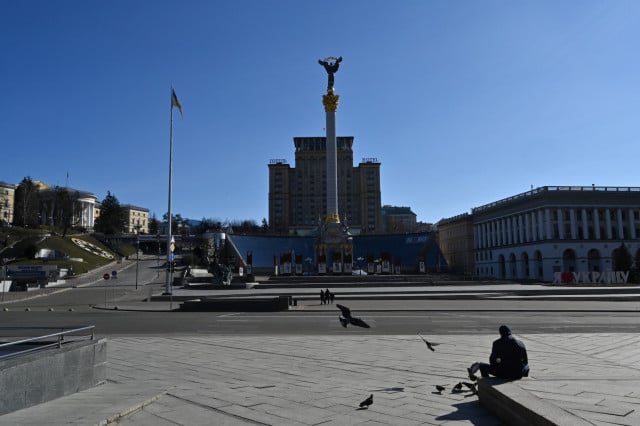We look at its tormented history:
- Dashed hopes -
After the outbreak of the Russian Revolution in February 1917, Ukrainians wanted to break free of the Russian Empire of which they had been a part for two centuries.
Ukrainian nationalists declared autonomy on November 20, 1917, and then independence in January 1918 with Kyiv as their capital.
The Bolsheviks had meanwhile proclaimed the Ukrainian Soviet Socialist Republic in the eastern city of Kharkiv.
Red Army soldiers took Kyiv on February 8, 1918.
With Russia losing World War I, the Bolsheviks signed the Treaty of Brest-Litovsk on March 3, 1918, and Germany occupied Ukraine.
It kicked the Bolsheviks out of Kyiv and backed a coup by a former general in the imperial Russian army.
After Germany's eventual defeat, the nationalists retook the city in December 1918.
- Poland intervenes -
Throughout 1919 Kyiv, like the rest of Ukraine, passed backwards and forwards between the warring Ukrainian nationalist, Tsarist "white" and the Soviet "red" armies.
In May 1920, with almost all of Ukraine in the hands of the Red Army, the nationalists turned to Poland for help. They retook the city only to evacuate it a month later and let the Bolsheviks in.
Ukraine became part of the Soviet Union along with other Soviet Socialist Republics in 1922.
- Soviets then Nazis -
The Soviet authorities stripped Kyiv of its status as capital in favour of Kharkiv as they sought to stamp out Ukrainian nationalism.
Mostly Russian-speaking Kharkiv remained the capital until 1934, when Kyiv took over again.
But seven years later it was devastated during World War II.
In June 1941 Kyiv was surrounded and bombarded by the invading Axis powers -- Germany, Hungary and Romania.
Much of its historic centre was destroyed by the retreating Soviet army and after a fierce 80-day battle, the Nazis entered Kyiv on September 19.
More than 30,000 people -- mostly Jews, but also prisoners of war -- were rounded up and shot at Babi Yar, close to Kyiv's present-day television tower.
Tens of thousands more died during the occupation, with most of the city's Jews killed in death camps.
- 'Hero city' -
In November 1943 the Soviets retook Kyiv but by then 40 percent of its buildings had been destroyed.
In 1965 it was awarded "hero city" status by the Soviet Union.
Although its industrial infrastructure was bolstered during its reconstruction, it remained in Moscow's shadow until the collapse of the Soviet Union in 1991.
That year Ukraine declared independence after a referendum with Kyiv again becoming a European capital.
- Two pro-European revolutions -
But stability was short-lived.
Kyiv's vast central Independence Square, popularly known as Maidan, was the epicentre of the massive 2004 pro-democracy "Orange Revolution" as well as the long pro-European uprising of 2013/2014 that sparked Russia's annexation of Crimea.
In November 2004, hundreds of thousands of Ukrainians turned out over three weeks to protest fraud-tainted polls which saw Kremlin-backed Viktor Yanukovych elected president.
The election was cancelled and pro-Western Viktor Yushchenko and Yulia Tymoshenko were elected.
Then nearly 10 years later, in November 2013, hundreds of thousands of pro-European demonstrators occupied the Maidan after Yanukovych -- back in power since 2010 -- turned his back on an association treaty with the European Union in favour of a rapprochement with Moscow.
The protests, which were marked by police violence, lasted day and night for three months.
After a bloodbath on the Maidan between February 18 and 20 when police opened fire, Yanukovych was impeached and fled to Russia.
rap/jmy/fg/raz
© Agence France-Presse
















